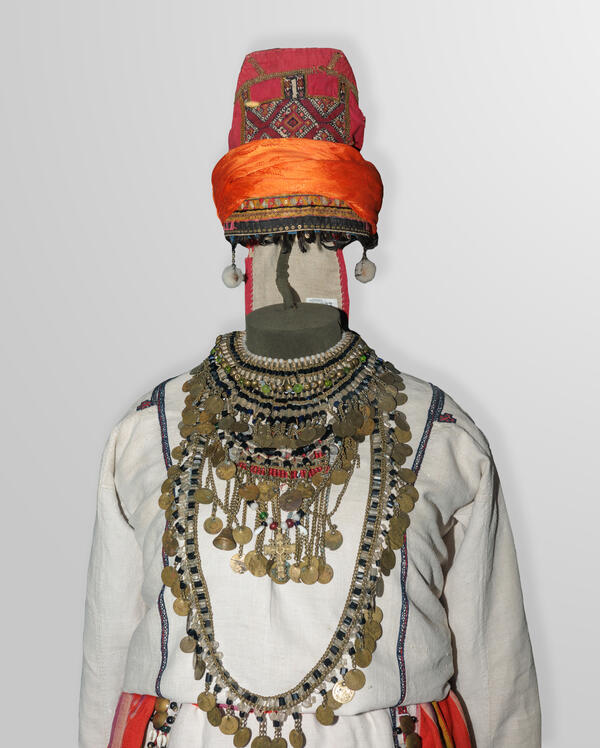The national costume reflects people’s ideas of beauty, its ethical norms and aesthetic ideals.
In most regions inhabited by Mordovians festive costumes are unified in their design. Health, strength, and endurance were considered the main assets of a woman in the traditional culture — and the costume emphasized these qualities. The bloused shirt, numerous pectoral and puffy hip adornments visually made a woman’s figure steady and heavy as if it grew out of the earth while their massive legs, neatly wrapped in white puttees, reminded of the trunks of birches. Wearing such clothes, the person moved in a slower, more composed manner.
There are traditional ways of putting on and wearing a multi-component clothing ensemble in the costume of a Moksha woman. A complete ensemble includes several canvas shirts richly decorated with embroidery, as well as pectoral and waist ornaments and a headdress with temple pendants. The Moksha costume was monolithic in silhouette, with strong emphasis on the features of the female figure. Women wore several finely embroidered shirts on holidays. The upper ozha ki shirt was a masterpiece of embroidery art. Lavishly embroidered and painted with black, dark blue and red threads, the homespun shirt would turn into a magnificent garment. Moksha women began decorating the shirt before it was sewn. Embroidered cloths were sewn in a certain sequence: first the upper part of the shirt, then the sleeves. The main embroidery pattern, which gave the shirt its name, was a broad band running down the sleeve, ozha ki (literally translated as “the sleeve’s way”). The deep chest neck of the shirt was pinned with a syulgam fastener. Rows of bugles, beads and glass beads were attached to it, alternating with chains and brass buttons. The syulgam was completed with rattle pendants — bells and tokens on long twisted chains. Necklaces, popular in the Moksha costume, were distinguished by their variety. Wide round shoulder-collars — tsifks — were considered especially revered by the northwestern Moksha. “You hear her first, and then you see her, ” was the popular saying about a Moksha woman.
The melodious bell jingling, according to folk beliefs, drove away evil spirits, so they were so often used in decorations. The full complex of a Moksha woman’s clothing attracted attention by its sound, bright coloring and elaborate design.
In most regions inhabited by Mordovians festive costumes are unified in their design. Health, strength, and endurance were considered the main assets of a woman in the traditional culture — and the costume emphasized these qualities. The bloused shirt, numerous pectoral and puffy hip adornments visually made a woman’s figure steady and heavy as if it grew out of the earth while their massive legs, neatly wrapped in white puttees, reminded of the trunks of birches. Wearing such clothes, the person moved in a slower, more composed manner.
There are traditional ways of putting on and wearing a multi-component clothing ensemble in the costume of a Moksha woman. A complete ensemble includes several canvas shirts richly decorated with embroidery, as well as pectoral and waist ornaments and a headdress with temple pendants. The Moksha costume was monolithic in silhouette, with strong emphasis on the features of the female figure. Women wore several finely embroidered shirts on holidays. The upper ozha ki shirt was a masterpiece of embroidery art. Lavishly embroidered and painted with black, dark blue and red threads, the homespun shirt would turn into a magnificent garment. Moksha women began decorating the shirt before it was sewn. Embroidered cloths were sewn in a certain sequence: first the upper part of the shirt, then the sleeves. The main embroidery pattern, which gave the shirt its name, was a broad band running down the sleeve, ozha ki (literally translated as “the sleeve’s way”). The deep chest neck of the shirt was pinned with a syulgam fastener. Rows of bugles, beads and glass beads were attached to it, alternating with chains and brass buttons. The syulgam was completed with rattle pendants — bells and tokens on long twisted chains. Necklaces, popular in the Moksha costume, were distinguished by their variety. Wide round shoulder-collars — tsifks — were considered especially revered by the northwestern Moksha. “You hear her first, and then you see her, ” was the popular saying about a Moksha woman.
The melodious bell jingling, according to folk beliefs, drove away evil spirits, so they were so often used in decorations. The full complex of a Moksha woman’s clothing attracted attention by its sound, bright coloring and elaborate design.




